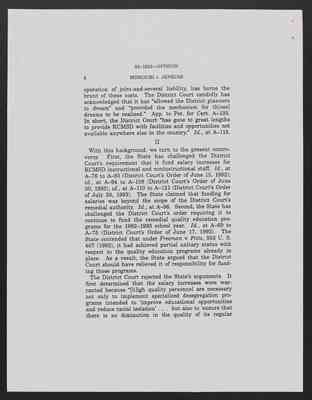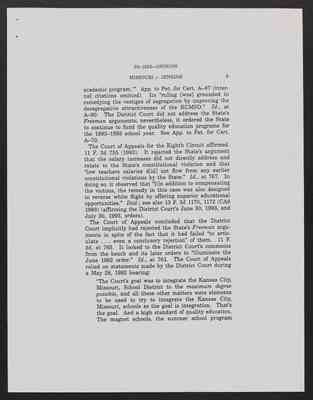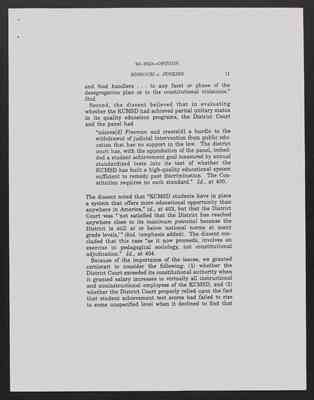Pages
11
7
93-1823—OPINION
MISSOURI v. JENKINS
3d, at 397 (Beam, J., dissenting from denial of rehearing en banc). The annual cost per pupil at the KCMSD far exceeds that of the neighboring SSD's or of any school district in Missouri. Nevertheless, the KCMSD, which has pursued a "friendly adversary" relationship with the plaintiffs, has continued to propose ever more expensive programs.2 As a result, the desegregation costs have escalated and now are approaching an annual cost of $200 million. These massive expenditures have financed
"high schools in which every classroom will have air conditioning, an alarm system, and 15 microcomputers; a 2,000-square-foot planetarium; green houses and vivariums; a 25-acre farm with an air-conditioned meeting room for 104 people; a Model United Nations wired for language translation; broadcast capable radio and television studios with an editing and animation lab; a temperature controlled art gallery; movie editing and screening rooms; a 3,500-square-foot dust-free diesel mechanics room; 1,875-square-foot elementary school animal rooms for use in a zoo project; swimming pools; and numerous other facilities." Jenkins II, 495 U. S., at 77 (KENNEDY, J., concurring in part and concurring in judgment).
Not surprisingly, the cost of this remedial plan has "far exceeded KCMSD's budget, or for that matter, its authority to tax." Id., at 60. The State, through the
- - - - - 2In April 1993, 16 years after this litigation began, the District Court acknowledged that the KCMSD and the plaintiffs had "barely addressed . . . how the KCMSD proposes to ultimately fund the school system developed under the desegregation plan." App. to Pet. for Cert. A—123. In the context of a proposal to extend funding of the magnet-school program for ten additional years at a cost of over $500 million, the District Court noted that "[t]he District's proposals do not include a viable method of financing any of the programs." Id., at A—140.
12
8
93-1823—OPINION
MISSOURI v. JENKINS
operation of joint-and-several liability, has borne the brunt of these costs. The District Court candidly has acknowledged that it has "allowed the District planners to dream" and "provided the mechanism for th[ose] dreams to be realized." App. to Pet. for Cert. A—133. In short, the District Court "has gone to great lengths to provide KCMSD with facilities and opportunities not available anywhere else in the country." Id., at A—115.
II
With this background, we turn to the present controversy. First, the State has challenged the District Court's requirement that it fund salary increases for KCMSD instructional and noninstructional staff. Id., at A—76 to A—93 (District Court's Order of June 15, 1992); id., at A—94 to A—109 (District Court's Order of June 30, 1993); id., at A—110 to A—121 (District Court's Order of July 30, 1993). The State claimed that funding for salaries was beyond the scope of the District Court's remedial authority. Id., at A—86. Second, the State has challenged the District Court's order requiring it to continue to fund the remedial quality education programs for the 1992—1993 school year. Id., at A—69 to A—75 (District Court's Order of June 17, 1992). The State contended that under Freeman v. Pitts, 503 U. S. 467 (1992), it had achieved partial unitary status with respect to the quality education programs already in place. As a result, the State argued that the District Court should have relieved it of responsibility for funding those programs.
The District Court rejected the State's arguments. It first determined that the salary increases were warranted because "[h]igh quality personnel are necessary not only to implement specialized desegregation programs intended to 'improve educational opportunities and reduce racial isolation' . . . but also to 'ensure that there is no diminution in the quality of its regular
13
9
93-1823—OPINION
MISSOURI v. JENKINS
academic program.' " App. to Pet. for Cert. A—87 (internal citations omitted). Its "ruling [was] grounded in remedying the vestiges of segregation by improving the desegregative attractiveness of the KCMSD." Id., at A—90. The District Court did not address the State's Freeman arguments; nevertheless, it ordered the State to continue to fund the quality education programs for the 1992—1993 school year. See App. to Pet. for Cert. A—70.
The Court of Appeals for the Eighth Circuit affirmed. 11 F. 3d 755 (1993). It rejected the State's argument that the salary increases did not directly address and relate to the State's constitutional violation and that "low teachers salaries d[id] not flow from any earlier constitutional violations by the State." Id., at 767. In doing so, it observed that "[i]n addition to compensating the victims, the remedy in this case was also designed to reverse white flight by offering superior educational opportunities." Ibid.; see also 13 F. 3d 1170, 1172 (CA8 1993) (affirming the District Court's June 30, 1993, and July 30, 1993, orders).
The Court of Appeals concluded that the District Court implicitly had rejected the State's Freeman arguments in spite of the fact that it had failed "to articulate . . . even a conclusory rejection" of them. 11 F. 3d, at 765. It looked to the District Court's comments from the bench and its later orders to "illuminate the June 1992 order." Id., at 761. The Court of Appeals relied on statements made by the District Court during a May 28, 1992 hearing:
"The Court's goal was to integrate the Kansas City, Missouri, School District to the maximum degree possible, and all these other matters were elements to be used to try to integrate the Kansas City, Missouri, schools so the goal is integration. That's the goal. And a high standard of quality education. The magnet schools, the summer school program
14
10
93-1823—OPINION
MISSOURI v. JENKINS
and all these programs are tied to that goal, and until such time as that goal has been reached, then we have not reached the goal. . . . The goal is to integrate the Kansas City, Missouri, School district. So I think we are wasting our time." 2 App. 482 (emphasis added).
See 11 F. 3d, at 761. Apparently, the Court of Appeals extrapolated from the findings regarding the magnet school program and later orders and imported those findings wholesale to reject the State's request for a determination of partial unitary status as to the quality education programs. See id., at 761—762. It found significant the District Court's determination that although "there had been a trend of improvement in academic achievement, . . . the school district was far from reaching its maximum potential because KCMSD is still at or below national norms at many grade levels." Ibid. It went on to say that with respect to quality education, "implementation of programs in and of itself is not sufficient. The test, after all, is whether the vestiges of segregation, here the system-wide reduction in student achievement, have been eliminated to the greatest extent practicable. The success of quality education programs must be measured by their effect on the students, particularly those who have been the victims of segregation." Id., at 766.
The Court of Appeals denied rehearing en banc, with five judges dissenting. 19 F. 3d, at 395. The dissent first examined the salary increases ordered by the District Court and characterized "the current effort by the KCMSD and the American Federation of Teachers . . . aided by the plaintiffs, to bypass the collective bargaining process" as "uncalled for" and "probably not an exercise reasonably related to the constitutional violations found by the court." Id., at 399. The dissent also "agree[d] with the [S]tate that logic d[id] not directly relate the pay of parking lot attendants, trash haulers
15
11
93-1823—OPINION
MISSOURI v. JENKINS
and food handlers . . . to any facet or phase of the desegregation plan or to the constitutional violations." Ibid.
Second, the dissent believed that in evaluating whether the KCMSD had achieved partial unitary status in its quality education programs, the District Court and the panel had
"misrea[d] Freeman and create[d] a hurdle to the withdrawal of judicial intervention from public education that has no support in the law. The district court has, with the approbation of the panel, imbedded a student achievement goal measured by annual standardized tests into its test of whether the KCMSD has built a high-quality educational system sufficient to remedy past discrimination. The Constitution requires no such standard." Id., at 400.
The dissent noted that "KCMSD students have in place a system that offers more educational opportunity than anywhere in America," id., at 403, but that the District Court was " ' not satisfied that the District has reached anywhere close to its maximum potential because the District is still at or below national norms at many grade levels,' " ibid. (emphasis added). The dissent concluded that this case "as it proceeds, involves an exercise in pedagogical sociology, not constitutional adjudication." Id., at 404.
Because of the importance of the issues, we granted certiorari to consider the following: (1) whether the District Court exceeded its constitutional authority when it granted salary increases to virtually all instructional and noninstructional employees of the KCMSD, and (2) whether the District Court properly relied upon the fact that student achievement test scores had failed to rise to some unspecified level when it declined to find that




